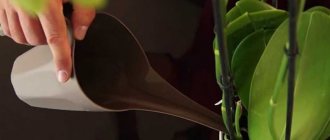Ideal pot size for violets
To successfully grow violets, it is very important to choose the optimal pot size. Indoor violets are picky about their maintenance conditions, and in order for the plant to delight you with lush flowering all year round, you need to pay attention to several important nuances when choosing a pot.
To determine the size of a pot for violets, you need to focus on the size of the rosette.
Photo of the “Favorite Daughter” variety.
Thus, to determine what size pot you need, use a simple rule:
Basic rules for growing violets on a windowsill
In order for Saintpaulias to delight you with long and lush flowering, the basic rules are followed during the growing process:
- create comfortable conditions and the necessary microclimate indicators in the room;
- follow care recommendations;
- promptly carry out preventive treatment against common diseases;
- regularly inspect the plant for the presence of pests or diseases and take measures for treatment;
- trim old leaves in a timely manner to preserve their decorative appearance and better nutrition of young leaves;
- after 2–3 years of life, the plant is rejuvenated (using a cutting or a rosette of several young leaves).
Size, material and color of the pot
To choose the ideal pot for Saintpaulia, you need to correctly decide on the size, material and color. There are containers on the market made of two materials: plastic and clay.
The advantages of plastic pots are:
The disadvantage is that the root system in them is poorly supplied with oxygen, but this can be corrected by a layer of drainage and increasing the holes.
The advantages of clay are a more aesthetic appearance and, in the absence of a coating, good ventilation of the roots.
When choosing a color scheme, it is worth noting that it is not recommended to choose plastic pots of bright colors , since they often emit harmful substances that poison the plant.
Pots of brightly colored flowers may release toxic substances.
When choosing a pot for a particular plant, you need to focus not only on the size of the rosette, but also on the variety. Depending on the description of the variety, you should choose the size of the pot according to the diameter of the declared rosette. It is worth noting that terry types of violets prefer flatter containers.
Standard containers available on the market
Buying a suitable pot for Saintpaulia is quite difficult . Stores sell larger pots than necessary.
Often, for large collections, round brown cups for seedlings or “seedlings”, disposable glasses, and yogurt jars are used, masking them with pots for greater aesthetics.
A small selection of which pots to plant violets in from those found in stores:
Finding ceramic pots in small sizes is even more difficult; as a rule, they are found only in online stores and are often out of stock.
For wick irrigation
For wick watering, you need to choose light pots with a diameter of no more than 7 cm. Choosing a larger diameter will lead to a strong growth of the rosette. The weight of the pots is recommended to be small , since the entire structure is already quite heavy and bulky.
For wick irrigation, you can use specialized pots , but they are difficult to find with a suitable diameter. It is much easier to use disposable cups or food containers.
Specialized pot for wick watering.
In the case of using disposable cups, the pot is placed in the cup so that there is at least 5 mm to the bottom. When using food containers, water is poured into them, and a hole is made in the lid through which the wick is threaded. The pot is placed on top of the container, on its lid.
Containers for wick irrigation
To plant bushes, pots are used, as in the usual cultivation of violets. The question is what to use as water tanks. They have to:
- do not evaporate the liquid;
- support the top container so that it stands straight and does not fall.
Typically, gardeners choose from two types of designs:
- The upper container fits tightly into the lower one, but does not fall through. There is enough distance between the bottoms of the violet pot and the water tank to fill the liquid. Half a liter is usually enough for 2 weeks. You can use food cups and cut eggplants. Ideally, choose a beautiful flowerpot of the appropriate diameter without a hole at the bottom.
- Use a container with a flat lid that is strong enough to support the weight of the flower pot as a reservoir. Make a hole in it for the wick.
Drainage is usually not added when watering violets this way. But peat with perlite is used as a substrate - this loose mixture does not clump together and can provide the best aeration.
Nuances of choosing a flowerpot
When choosing a pot for indoor violets, do not forget about the specific growth of Saintpaulia roots. Violet roots grow close to the surface and develop poorly in length.
Over time, a new root system forms on the stems after the lower leaves die. In their natural environment, violets grow in rocky soils and for the best development of the plant it is necessary to provide maximum air access to the roots.
You should not transplant a standard violet into a pot larger than the maximum recommended size.
If replanting is necessary, you need to remove excess soil and dying roots and replant them in a pot of the same diameter. If a larger pot is selected, several problems may arise:
Use the following tips when choosing what size pots should be:
How not to flood a flower?
It is necessary to know whether the soaking of violets depends on the thickness of the wick. The main danger and problem with wick watering is waterlogging of the soil, which leads to rotting and death of the violet.
To avoid this outcome, it is important to choose the right substrate; the most reliable is a mixture of perlite and peat.
Another important component is the wick:
- The thickness of the wick should correspond to the size of the outlet;
- And the length should be optimal and fit in a circle inside the pot, reach the bottom of the container and lie 1-2 cm on its bottom.
Properly organized wick irrigation prevents the problem of waterlogging.
What pots are best for violets?
Violet or, as it is often called, Saintpaulia, is a fairly common indoor plant that combines beauty, unpretentiousness and compactness. For these qualities, the flower is highly valued and is actively grown by novice gardeners. On store shelves today you can see a wide range of pots. It is very important to choose the right container. The article will tell you what pots to plant violets in and how planting is carried out.
Is it possible to replant a blooming violet?
If there is no urgent need, you should not replant the violet during flowering. Although there are varieties that bloom most of the year, and they have to be replanted at the flowering or budding stage. If the owner does not have enough experience, it is better to carefully remove the flowers and buds when replanting. When it is a pity to do this, and replanting is necessary, it can only be done by transshipment, with maximum preservation of the old earthen clod. If replanting is required due to illness or acidification of the soil, you should not think about the flowers, but save the plant. All buds are torn off, the roots are processed, and Saintpaulia is planted in fresh soil.
What to look for when choosing a pot?
You need to understand what kind of pots are needed for violets, otherwise there is a chance of buying the wrong container. Growing in an uncomfortable pot, the crop may begin to get sick and stop blooming. There is even a risk of death. The most important parameters when choosing a container are its size and material of manufacture. You can read the article: Garden and home gerbera flowers - recommendations for growing.
Size and size of container
First you need to decide on the size.
Saintpaulia's roots do not grow deep, but along the surface of the earthen clod. Even in nature, the roots do not go deep into the soil. This is due to the proximity to nutrients, air and light. Therefore, the culture does not need a deep container. When choosing the size of a pot for violets, it is important to consider the size of the plant. For example, for an adult large flower, a container 9 centimeters high is suitable. In this case, the diameter of the pot should always be equal to the height, that is, also be 9 centimeters. It happens that a flower grows so much that it no longer fits in such a flowerpot. But you shouldn’t look for larger containers. Simply shake off some of the soil and replant the crop into a container of a similar size. Larger variants can lead to the death of the plant.
But when growing medium-sized plants, it is better to give preference to a container of 7x7 centimeters.
Pots for mini-violets or young Saintpaulias, the diameter and height of which are 5 centimeters, would be ideal.
If you plant violets in large pots, they will grow leaves intensively. But there will be very few flowers. You should not expect flowering within two years. In addition, the soil, which is not covered by roots, turns sour and deteriorates. Various insect pests begin to appear in it, and fungal infections develop. In this case, it is often necessary to destroy the culture. Spacious containers are justified only in the case of growing mother Saintpaulia for further seedlings and selection.
The ideal pot should be three times smaller than the diameter of the Saintpaulia rosette. Only in such cramped conditions will the violet feel comfortable. This means you will be pleased with beautiful flowers.
Container material
When the volume of the pot is selected, the material is determined. The store shelves offer a wide selection of products made using various raw materials. They differ not only in appearance, but also have different effects on the plant.
The following options are usually used:
Experienced gardeners say that the best pots for Saintpaulias are those made of plastic or clay. Sometimes transparent plastic glasses and cut-off bottles are used to grow Saintpaulias. Such containers look very unattractive. For camouflage, beautiful larger pots are used.
Can the pot be reused?
The pots in which violets were grown can be reused. But it is important to process them correctly in order to prevent infection of the plant.
How to clean
You can clean the violet bowl with any detergent used in the kitchen. It is important to avoid aggressive chemicals.
Additional Information! Some types of containers must be heat treated before being reused. To do this, use a conventional oven preheated to a temperature of 200 ℃.
How to fix
Only products made of ceramics or clay can be repaired. To do this, the polymer is melted and all the parts of the pot are glued together using the resulting liquid. Other adhesives are not recommended as they negatively affect the condition of the flower.
If you take into account all the tips for choosing pots for growing violets, it is possible to grow a fragrant flower. These plants will be an excellent addition to the interior.
How to grow violets in a pot?
To get a healthy and beautiful plant, you need to have certain knowledge and experience. It is important to plant correctly. Know when a transplant is needed and how it is performed. You will also need to organize good care for the flower.
Planting violets in a pot
Breeders usually propagate Saintpaulia from seeds. But this process is very labor-intensive, complex and long. Therefore, it is better for beginners not to use this method. It is better to understand how to properly plant a violet in a pot with a leaf, as well as how to transplant the plant into a more spacious pot.
To plant a violet leaf in a pot, you need to prepare the following:
Particular attention should be paid to the planting material, so the leaves should be taken those located in the second row of the rosette.
It is in them that all the nutrients necessary for active growth have accumulated. The sheet must be carefully inspected to ensure that there are no defects such as dents, scratches, burns, etc. Otherwise, the planted material will rot. Yellowed leaves are not suitable. The supply of vitality in them is exhausted, and it will not be possible to get a healthy, full-fledged plant from them.
The algorithm for planting a violet in a pot with a leaf is given below:
Transplanting the culture into another container
After just a few months, the violet will delight you with thick, beautiful inflorescences. When the crop grows, you will have to transplant the violet into a larger pot. A transplant may be needed in other cases.
In any case, you need to understand how to transplant a violet into another pot correctly. If this procedure is not carried out on time, there is a risk of losing the plant. Vases from diseased crops should absolutely not be used.
How to replant a violet in a pot is described below:
Frequent content problems
Sometimes Saintpaulia begins to fade and becomes covered in spots.
Often the reasons why a violet in a pot withers is due to mistakes in care. For example, a combination of low temperature with systematic waterlogging of the soil can provoke this condition. Impact fertilizing can cause root burns. Because of this, the leaves will also wither. Often wilting is a symptom of fungal infection, rot, or parasite damage. If the plant is in poor condition due to errors in agricultural technology, it is enough to simply adjust its care. But if the culprits are pathogenic microorganisms or insects, the plant will have to be saved. For this purpose special preparations are used. For example, Aktar.
How can I fix the situation?
If a problem is identified early, you need to act very quickly. Simply placing the plant in a smaller pot will not be enough. The violet should be removed along with a lump of earth and left to dry in the fresh air for 24 hours. Then remove excess soil and replant the flower in a smaller container.
If the pot, on the contrary, was small, then you need to transplant the plant into a larger container along with a lump of earth.
Not a warehouse, but a place to relax: how to decorate a balcony on a minimal budget
Pleated and print: how and with what to wear basic skirts in the warm season
“Coronavirus” benefits that will be canceled in the Russian Federation on April 1 have been named
To minimize the risk of waterlogging, when planting violets, you need to put a drainage layer in the container or make special drainage holes at the bottom.
Is it allowed to grow several Saintpaulias in one pot?
Gardeners often wonder whether different varieties of violets can grow in the same pot.
In principle, this is acceptable. The main thing is that the sizes of the rosette varieties are approximately the same. However, some gardeners do not recommend planting crops in one flowerpot. After all, if you plan to cultivate two violets in a pot, then you will need to choose a spacious container. And Saintpaulia prefers close quarters. In a large container, all the energy of the violets will be spent on the development of the root system. As a result, both plants will not bloom. Violet looks very delicate and beautiful. It can often be found on the window sills of city apartments and private houses. But to get a good symmetrical plant with abundant flowering, you need to choose a pot that is ideal in size and made of good material. You can actually make a flowerpot yourself from clay, plaster, or weave it from plant branches. See the article: Indoor ficus - popular types and main rules for home care.
Source
The Scarlet Flower
“Scarlet Flower” produced in Russia is convenient for plants, when watering which it is necessary to avoid getting liquid on the leaves: violets, streptocarpus, orchids. The product is well suited for bottom watering. The system consists of 3 parts made of plastic. From 2 parts you need to make a tray into which liquid for irrigation is poured. In the third, equipped with a large number of small holes, Saintpaulia is planted.
When choosing which pots for violets to purchase, you should take into account that the size of such a product is small and is better suited for young plants.
When planting, the rosette should not be buried in the soil mixture. There is no need for drainage. The container with Saintpaulia is located 1-1.5 cm above the tray. It is not difficult to remove the top part. “The Scarlet Flower” is easy to use and can serve for a long period of time.
The ideal pot for violets: which one is better to choose?
Violets are indoor plants that can be classified as average in terms of difficulty of growing. Whether an attempt to grow this flower will be successful or not depends on many factors.
There are many flower growers for whom it disappears quite quickly, but there are also those who consider them to be the simplest even for novice flower growers. For a successful attempt, it is important to follow all the recommendations of experienced flower growers.
Choosing the right container for growing is not the least important aspect of care. If the flower pot is incorrect, the plant may die and inexperienced gardeners will not even understand the cause of the disease and death. That is why in this article we analyze which pot is good for Saintpaulias.
Signs that the pot is chosen incorrectly
Violets take root very quickly, and in just a couple of weeks you can see how correctly the container was chosen. You need to carefully monitor the plant, since if the problem is not detected in a timely manner, the flowers quickly die and it may be very late.
Miracle or legend: Samara local historians conducted an investigation into “Zoya’s Standing”
Restore blood vessels after coronavirus: recommendations from a therapist
Bob is still at the peak of fashion. Ideas for fashionable and stylish bob haircuts
A sign of an incorrectly selected container is that the leaves on the violet droop and the flowers dry out and wither. After a while they begin to die off. Rot and mold form on the leaves and near the roots. This means that the pot is too big for the violet.
Even if all these signs are absent, it is known that in a container that is too large, violets bloom much worse and gain much more green mass.
If the pot is too small, then the plant stops developing, blooming, begins to dry out, and gradually loses leaves that become deformed.
Features of the development of the root system of violets
Violets grow in the tropics and the place where they grow is abundant in moisture and nutrients, which is what leads to shallow root growth. The root system of Saintpaulia rarely grows in depth and entwines the lump from top to bottom.
Violet takes the bulk of its microelements from the upper and middle levels of the earthen coma. But most of the water is absorbed from the bottom layer. This distribution system determines the type of ideal watering, namely from below (into a pan, wick).
You can water Saintpaulia under the leaves, but this procedure requires care, because water should not get into the core.
Basic mistakes
Below are the main and most typical mistakes that gardeners make when choosing a pot for violets; familiarizing yourself with them will help prevent a possible repetition in the future:
The absence of a drainage layer in the pot, which leads to stagnation of water in the lower layers of the soil and subsequent rotting of the root shoots.
Placing the pot in direct sunlight or in close proximity to artificial light sources
All varieties of violets are heat-loving, but they do not tolerate direct exposure to rays, so special attention should be paid not only to the choice of container for growing, but also to its location.
Violation of depth indicators when transplanting into another pot. You should not try to immerse the cutting as deeply as possible into the soil, as this may lead to the flower not taking root in the new place at all.
Pot for violets: which one is better to choose?
When the first euphoria after buying a violet wears off, the novice gardener asks the question in which pots is best to grow this flower. And the need for a speedy transfer from the transport container requires determining the answer as soon as possible.
Size
The main point in choosing a flowerpot can rightfully be considered its size. If the pot is not the right size, various problems may arise:
Choosing the ideal pot depends on the age of the violet, its type and the condition of the root system. The best sizes are:
A reminder of what the pot should be like (photo with recommended dimensions).
Depending on the type of watering, the size of the pot may vary. For classic watering in a tray, the above dimensions are suitable. If watering is wick, then the size is reduced by one and a half to two times.
It is also important to take into account the condition of the root system - if there is damage or disease in this part, the flowerpot is reduced to the required size. And given that different varieties develop at different speeds, the ideal pot size can be selected depending on the size of the root system - the roots should occupy from 1/3 to 2/3 of the earthen ball.
Material of manufacture
Pots for indoor plants are made from different materials and it is important to choose the ideal option for each specific flower. Pots on the market mostly come in a variety of varieties, so how do you choose the best one?
Clay
When choosing which pot to plant your violet in, take a closer look at clay containers. The naturalness of the material and its breathability are ideal for violets, so this type is one of the best options.
Clay pots come in different sizes and shapes, and almost all varieties have a drainage hole.
The advantages also include the aesthetic appearance of the flowerpots and the ability, if desired, to decorate their outside using painting or other devices.
They also have disadvantages:
Ceramics
Ceramic flowerpots can be glazed or unglazed. For violets, non-drenched ones are better suited ; they breathe, but dipped ones have a more aesthetic appearance, and the former also lose their appearance over time.
Among the disadvantages of ceramic flowerpots are fragility and the inability to make additional drainage holes.
There are different types of such pots, but most have no drainage at all or one small hole . A ceramic pot is better suited for decoration ; you can put an unattractive flowerpot inside and get an aesthetic appearance.
Ceramic pots are best used as flowerpots.
Plastic
When researching which pot is suitable for growing violets, know that plastic containers are considered the best among others. The size range includes all the necessary sizes for violets.
When transplanting, the roots do not cling to anything, and the pots can be easily treated for parasites or diseases if necessary. The drainage holes are large and there are many of them, and the bends at the bottom of the pot are an additional advantage for air circulation.
Among the shortcomings, only appearance can be mentioned , but this depends on everyone’s personal opinion. The flowerpots are quite neat and monochromatic; they can be decorated or hidden inside another.
Plastic
Plastic ones are quite practical, they look better than plastic ones due to the variety of shapes and colors.
The pots are convenient both during cultivation and during transplantation; it is easy to make additional drainage holes in them. The disadvantage is the risk of buying a toxic pot. This type of painting is carried out with aniline paints, which can release harmful substances into the soil, which can kill the plant. plastic pots that are not bright, beige or white.
How to do it yourself?
Many flower growers, in order to save money, improve appearance, or because they know better what kind of pot the violet likes, make flowerpots themselves from improvised materials or specially purchase materials.
Some of them are well suited for decorating unattractive purchased pots, others can completely replace them.
Cement and gypsum
Flowerpots made of plaster or cement are well suited for decorating purchased pots or for wicking violets. They are not suitable for use as main containers, this is due to the unevenness of the internal surface and the difficulty in creating drainage holes.
The creation sequence is very simple:
The resulting pots can be used as planned. If there is a need to make drainage holes, they are drilled (this must be done carefully, because the pot may crack) or the containers are immediately placed so that a hole is formed in the process.
Wicker
Pots are woven from wicker , then they can even be used as main ones. Weaving can also be done from other materials, such as newspaper tubes, straw and strands , but such a flowerpot can only be used as decoration for main containers.
Pots made from newspaper tubes.
Flowerpots made of clay (polymer clay, regular clay, pottery clay)
The basis for the pot can be clay; for this, polymer or pottery clay is usually used, in rare cases ordinary clay. The difficulty in creating arises at the baking stage , because you need to carry out this process correctly, and reliability and appearance depend on this.
The advantage of such flowerpots is the ability to mold any shape and make the required number of holes. Naturalness also
Other types
Pots for violets are also made from plastic cups, sour cream glasses or other containers Cups of different sizes are used for propagating violets; it is cheap and convenient, because they need to be changed frequently as the children grow.
For wick irrigation
Wick irrigation can be arranged in several ways:
Which one to choose from the list presented is up to you.
From improvised means
Homemade pots made from cups or other containers are often used for wick watering. To do this, choose two glasses of different volumes , but the circumference of the larger glass should be the same as that of the smaller one.
They plant the plant in the smaller one, placing the wick inside, take water into the larger one and place one inside the other.
Purchased non-specialized
In this option, a plastic pot is purchased for planting . Planting is carried out with a wick, as in the previous version. And the container for watering is used as desired; it can be a handy container or a purchased pot of larger volume, with a narrow top and without holes.
The variety of flowerpots in stores allows you to choose the appropriate option and get a beautiful result.
One of the options for organizing wick irrigation.
Specialized
The simplest and most expensive option. Such flowerpots are sold immediately with everything you need; you just need to plant the violet in the inner container, pour water into the outer one and place one in the other. The cost of such pots starts from 200 rubles, then the price depends on the size, design and quality of the flowerpot.
The good thing about such pots is that you don’t have to rack your brains about how to choose the right container; the manufacturer has come up with everything for you.
With automatic watering
Automatic watering is a good option for those who do not have time to seriously care for violets. Only wick watering of Saintpaulias can be classified as automatic watering ; it can be arranged in different ways.
Wick irrigation is convenient and quite economical; as described above, it can be installed with a minimum of effort and money.
In a pot with automatic watering, the supply of moisture occurs due to the fact that the water from the container below rises upward , the earthen lump takes only the amount of water that is needed.
Take a closer look at this system if you are now looking for information about what kind of pot you need (you can see a photo of this pot on the right).
Pot Scarlet Flower from the manufacturer Tekhosnastka
Scarlet Flower pots are one of the options for ready-made containers for wick watering, which can also be used in the classic version. Comfortable, plastic, brightly colored and proven quality. Their design is thought out to the smallest detail, they are aesthetically beautiful, and the upper sloping side does not cut leaves.
Flower growers who have tried these pots have only good things to say about them. Everyone finds advantages for themselves; the only disadvantages mentioned were the small volume of the water bowl if you use a pot for wick watering.
Pot Scarlet Flower.
How to plant violets from a leaf: step-by-step instructions
So, you have a violet leaf. What should we do with it? And how can you get a whole plant from one leaf? First, choose how you will grow the “babies”: by immediately placing the leaf in the ground or by rooting it in water? The first method is faster, but the second is simpler and more suitable for beginners.
Want to learn how to plant violets with leaves?
- A healthy leaf is trimmed so that the stem is no more than 1/3 of the total size of the plant. Then the soil is prepared: drainage and soil. The ideal pot for growing violets is from a leaf no more than 5 centimeters in diameter. You can use a plastic yogurt mold, which works great.
- Make a small depression in the soil and place finely chopped moss there; it will help strengthen the leaf so that roots can appear. Not everyone knows how to properly plant violets from the leaf, so often the “babies” are prevented from germinating by a dense layer of soil.
- Sprinkle the stem with soil, lightly pour warm boiled water over it and cover with plastic wrap (an ordinary bag will do). This way you can create greenhouse conditions for the plant. Monitor the room temperature, it should be kept at 22-25 degrees. You need to water the soil as it dries. After a while you will notice small violets sprouting.
But there is another option for preparing the sheet.
- Pure, settled water at room temperature is poured into a glass and a leaf is placed there. Keep an eye on the water level and also watch the roots grow. They will begin to appear within 7-9 days, and by the beginning of the second week the plant will be ready for transplanting.
- As soon as the roots have grown 1-1.5 centimeters, the leaf can be rooted. You can use a combination of two cups of different sizes (the smaller one should have drainage holes) or use expanded clay or other drainage. It is poured in a layer of 1/3 of the total height of the pot, then the soil is placed.
- Make a small hole in the ground where you need to plant the violet. The root system will prevent the plant from falling over on its side. Sprinkle the sprout with soil and water with warm water.
- The top of the plant is covered with polyethylene and ideal conditions for growth are created: constant temperature, light. Sprouts will soon appear.
Now you know how to plant violets in a pot. But there is another technique for growing plants.
DIY pot
You can make a cute container for violets yourself. For example, from a sour cream cup:
- Remove the film or label with the name, otherwise the container will not look like a pot. If it is printed with paint, scrape it off with a stationery knife.
- Measure 6 cm from the bottom, make a mark with a marker in a circle in several places. Connect straight. Check whether the side height is the same.
- Make a hole on the circular line. Carefully cut off the lower part with scissors.
- The result is a flexible, easily deformed container with an edge that can hurt you. The situation is corrected using the top of the cup.
- The ring is cut to create a strip. Insert into the bottom of the container.
- The edges of the side will overlap each other. Excess plastic is carefully measured and removed.
- Place the workpiece in place and slide it down until it stops.
- Staple to the main container with a stapler, starting from the middle of the strip. This way the edges will meet nicely and be at the same level.
- Make the lower holes with a hot nail. For the wick - one in the center. If watering is normal, it is better to burn a few holes in the bottom.
Reproduction
To propagate the variety you like, you can use the “from the leaf” planting method.
Recommendations on how to properly plant a violet leaf are as follows:
- a violet leaf, cut from the 2nd or 3rd tier, is placed in a container with water;
- It is advisable to take an opaque container, and the water should be settled or boiled;
- the sheet is strengthened so that it is immersed in water by 1.5-2 cm and does not touch the walls;
- After the roots appear, the small plant is planted in the ground, following the technology.
Planting directly into the soil is preferable. The plant immediately takes root in the pot and does not experience stress during transplantation. The leaf cuttings are planted to a depth of 0.5 cm in prepared, moistened soil mixture. A mini-greenhouse is built on top.
What do you need to plant violets?
We advise you to prepare in advance and purchase all the necessary materials. This approach will greatly simplify the task. If you do not know how to plant violets correctly and cannot choose a method, then prepare a complete list of materials. Among them:
- several pots of different sizes;
- special soil for violets (you can find it in stores);
- plastic containers (you can take either yogurt cups or regular transparent ones);
- a small shovel that allows you to work with the soil;
- fertilizers (also suitable for violets);
- lamps (relevant for dark rooms and for the winter period).











